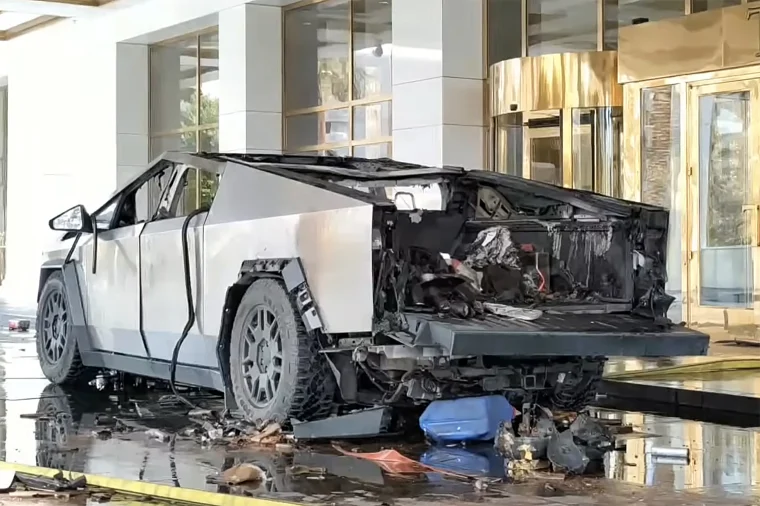Las Vegas, NV – Following a dramatic explosion of a Tesla Cybertruck outside the Trump International Hotel in Las Vegas on Wednesday, which resulted in the death of the vehicle’s driver and injuries to seven others, Tesla CEO Elon Musk has committed to aiding the investigation by sending his teams to recover video footage and data from the severely damaged Cybertruck.
The Las Vegas Metropolitan Police Department, led by Sheriff Kevin McMahill, confirmed the presence of explosive materials, including gasoline canisters, camp fuel canisters, and large firework mortars in the truck. The Cybertruck, which was caught on camera exploding, had its blast directed upwards, minimizing external damage, with the glass doors of the hotel remaining intact.
Musk has been vocal on X about the incident, pointing out the vehicle’s design which “limited the blast damage.” He shared clips and comments from the Sheriff, noting, “The evil knuckleheads picked the wrong vehicle for a terrorist attack.” Musk emphasized that the explosion was not due to any malfunction of the Cybertruck, stating, “All vehicle telemetry was positive at the time of the explosion.”
Amidst the investigation, Musk’s teams are set to retrieve crucial in-cabin video footage and data, which could shed light on the moments leading up to the blast. This step is critical as numerous questions arise not only about the motive of the deceased suspect but also under perplexing circumstances surrounding his death. Reports indicate that the suspect, identified as Matthew Alan Livelsberger, an active-duty Army Green Beret, reportedly shot himself before the explosion. Additionally, there are claims that he changed his Signal safety number both before and immediately after the blast, raising suspicions about the sequence of events.
The family of the deceased has suggested that Livelsberger might have been set up, leading to speculations about the truck potentially being operated on autopilot after his death to position it in front of Trump Tower. This theory would imply a complex orchestration involving remote access to the vehicle’s controls, a feature not officially acknowledged by Tesla for such scenarios. Several users on X have also shared screen shots showing the suspect changed his Signal Safety Number before and then right after the explosion, causing wide speculation that there is way more to this story than what is being reported.
Sheriff McMahill expressed appreciation for Musk’s assistance, which includes providing video from Tesla’s charging stations, aiding in tracing the vehicle’s path. The involvement of Turo, the car-sharing service from which the Cybertruck was rented, links this incident with another attack in New Orleans on the same day, where a vehicle was similarly used.
The investigation is now delving into whether this was an isolated incident or part of a broader scheme, with particular focus on the technical capabilities of the Cybertruck and the possibility of its misuse in such a context. The recovery of video and data by Musk’s team could be pivotal in answering these questions, potentially revealing if there was any manipulation of the vehicle or if the suspect acted alone.
This incident not only raises security concerns about vehicle usage but also brings to light the complexities of modern technology in potential terrorist acts or setups.

